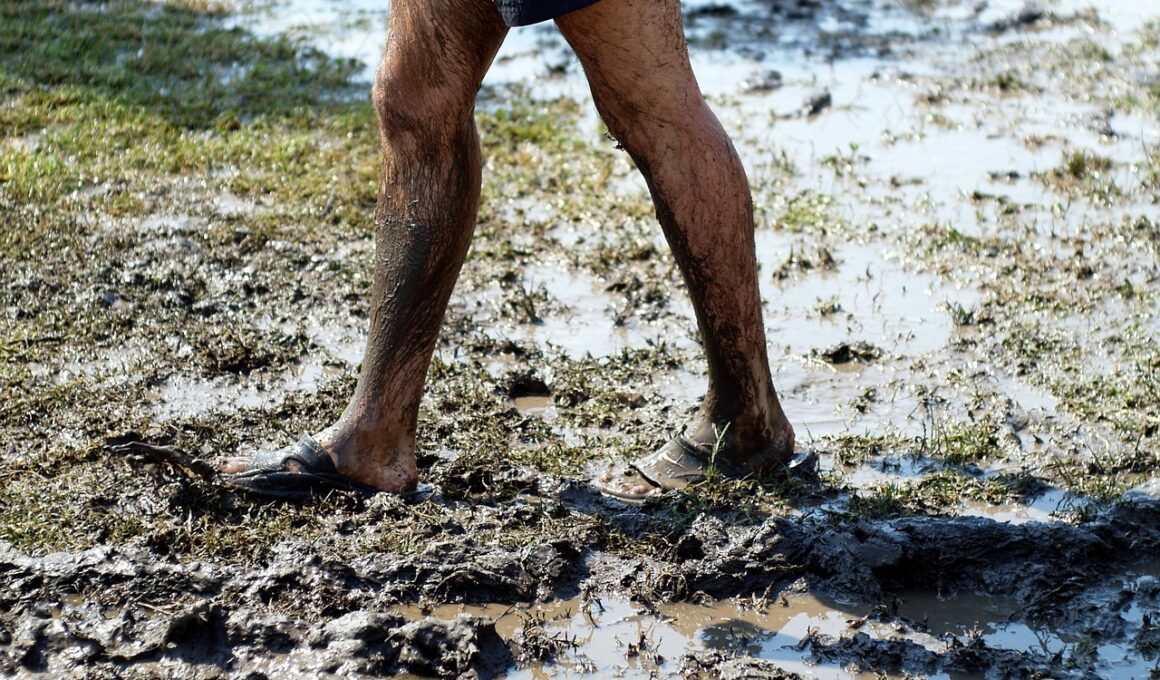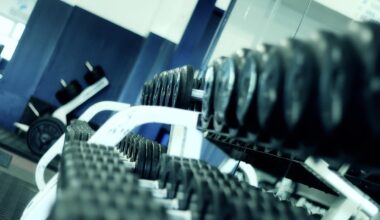Cross-Training for Mud Runs: Incorporating Water Sports
Mud runs are increasingly popular, attracting adventurous athletes seeking challenges through various terrains and obstacles. To excel in mud runs, effective cross-training can significantly boost performance, and incorporating water sports immerses participants in a dynamic training environment. Water activities allow individuals to develop strength, endurance, and flexibility—all crucial for tackling mud run challenges. From paddleboarding to kayaking, these sports provide varied techniques that enhance cardiovascular health. The natural resistance offered by water is particularly beneficial for building muscle without the strain of traditional weightlifting. With regular training in water alongside traditional runs, participants can experience remarkable improvements in overall performance, swiftly adapting to the demands of muddy courses. Additionally, incorporating water sports can help prevent injuries. The buoyancy of water reduces impact on joints, making workouts more tolerable for those recovering from injuries. Creating an enjoyable workout routine increases motivation and engagement, allowing for a consistent training schedule. Ultimately, marrying water sports with traditional mud run preparation equips athletes with the stamina needed to conquer challenging courses ahead, setting them on a path to success in their mud running endeavors.
Incorporating swimming techniques serves as an outstanding foundation for improving mud run performance. This engaging activity not only builds upper body strength but also enhances cardiovascular endurance, ensuring athletes efficiently navigate through muddy challenges. Swimming, particularly stroke variations like freestyle and breaststroke, promotes the development of seamless movement patterns vital for maneuvering through obstacles. Moreover, during mud runs, participants often face unpredictable conditions, mirroring the experience gained in swimming pools or open water environments. By adopting a variety of swimming drills, athletes cultivate endurance and power while learning how to stay calm under pressure—essential skills when tackling muddy terrains. Confidence in water translates to adaptability and resilience on land. Alternatively, activities such as synchronized swimming or water aerobics stimulate balance and coordination, both important qualities for successful mud runs. Incorporating these unique water-based workouts into training will not only break the monotony but also enhance physical proficiency, producing well-rounded athletes who can perform excellently across diverse obstacles. Ultimately, engaging in structured swimming sessions fosters adaptability and ease in overcoming unexpected challenges encountered during actual mud runs.
Exploring Kayaking and Canoeing
Another remarkable way to cross-train is by engaging in kayaking or canoeing, which builds essential strength in the upper body, core, and legs. This dynamic sports challenge also helps athletes develop endurance while navigating through water, boosting cardiovascular fitness. When tackling mud runs, paddling skills translate to improved technique when climbing over obstacles, running through rugged terrains, and sprinting in soft, muddy environments. Moreover, as participants maneuver their watercraft, they cultivate balance, coordination, and navigation skills. Such experiences are invaluable, particularly during tough mud races where racecourse obstacles demand quick decision-making and clear vision. The focused movements of kayaking and canoeing strengthen stabilizing muscles and enhance flexibility. These qualities are directly beneficial to performance in mud runs, invoking powerful movements versus just relying upon brute strength. Additionally, enduring longer paddling sessions helps enhance stamina levels, enabling athletes to maintain energy longer while racing. Kayaking and canoeing not only improve physical attributes but also provide a unique sense of adventure, making cross-training enjoyable and memorable. From exploring rivers to tackling lakes, athletes can embrace nature while refining their skills, ensuring they are prepared for muddy experiences ahead.
Stand-up paddleboarding (SUP) represents an excellent alternative for individuals seeking to integrate fun with an effective workout routine that supports mud run preparation. This water sport combines elements of balance, coordination, and endurance, allowing athletes to develop overall body strength while engaging in unique challenges on the water. As participants navigate across the water’s surface, their core muscles work tirelessly to maintain stability, mirroring the need for balance during mud runs. Consistent practice on a paddleboard not only targets lower body strength but also emphasizes arm and shoulder development, crucial for sprinting through muddy paths. Moreover, stand-up paddleboarding enhances cardiovascular fitness and flexibility, key components when facing a range of obstacles. One of SUP’s key benefits is that it encourages mental well-being through mindfulness and relaxation, helping athletes recharge mentally and physically. The sense of accomplishment derived from mastering new skills also serves to motivate individuals in their training regimen. Additionally, teamwork activities like paddling with friends create an enjoyable environment while honing skills vital to mud runs. Ultimately, stand-up paddleboarding offers a unique, effective way to prepare for the rigorous demands of mud runs, providing athletes with both enjoyment and fitness benefits.
Benefits of Water Sports on Recovery
Participating in water sports plays a significant role in active recovery, essential for athletes intensifying their training routines. Following intense mud run sessions, athletes need appropriate recovery protocols to prevent burnout or injuries effectively. Low-impact activities such as swimming, kayaking, or paddleboarding enable the body to recover while still engaging muscles without undue strain. The buoyant nature of water reduces gravitational effects, allowing athletes to exercise in ways which facilitate blood circulation and maintain fitness levels without exacerbating muscle soreness. Water sports are also beneficial for maintaining consistency within training schedules when dealing with adverse weather conditions. Exercising in diverse environments prepares athletes mentally and physically for the unpredictable obstacles encountered during mud runs. Moreover, these activities help reduce overall stress, promoting a sense of enjoyment and accomplishment within the training routine. Establishing a consistent recovery plan that incorporates water sports effectively enhances performance and ensures that athletes continue evolving in their abilities. In summary, athletes motivated to amplify their preparation for mud runs should prioritize engaging in water sports, as they provide ample recovery opportunities and additional benefits that elevate overall performance levels.
Another key factor in designing a successful cross-training routine for mud runs includes focusing on the mental aspect of training. Engaging in water sports not only builds physical strength but also cultivates mental resilience crucial for overcoming difficulties presented throughout demanding courses. The challenges athletes face while participating in water-based activities teach perseverance and adaptability, critical traits that translate to better performance during actual events. Therefore, training in a variety of settings helps create well-rounded pathways to success in overcoming obstacles and tackles unpredictability. As athletes learn to adapt to changing water conditions and declining performance rates in open water, they simultaneously enhance their capacity to handle pressure faced during a mud run. In addition, the element of enjoyment from water sports serves to promote a positive attitude and mitigate the mental fatigue that can accompany arduous training. It’s vital for athletes to introduce variations and exciting elements into their routines, ultimately contributing to overall enthusiasm and long-term commitment towards success. Athletes should embrace the connection between mental resilience gained through water sports and the grueling challenges presented during mud runs, as both are intertwined in achieving peak performance.
In Conclusion
Incorporating water sports into cross-training programs provides athletes with numerous advantages in preparing for mud runs. By engaging in various water-based activities, athletes enhance their overall fitness levels, tackling endurance, strength, and flexibility components essential for racing through muddy terrains. From swimming to paddleboarding, each water sport offers unique benefits that complement traditional mud run training, making routines well-rounded and enjoyable. The mental aspect of these activities—not just physical—trains individuals to face challenges, enabling them to approach obstacles with resilience and confidence. In essence, athletes benefit greatly from the vibrant energy that water sports introduce. Furthermore, they promote active recovery, allowing the body to recuperate while maintaining fitness levels where other forms may hinder progress. Addressing individual needs and preferences, it’s crucial for athletes to design personalized routines, incorporating innovative and creative methods that embody overall fitness goals. Ultimately, embracing water sports complements mud run training in unexpected and extraordinary ways, establishing a pathway to success. Every athlete seeking to conquer muddy courses should harness water’s ability to enhance agility, strength, and endurance, ensuring an unforgettable experience on their journey towards accomplishment.
Adopting the mentality of constant evolution is vital for athletes pursuing their goals in both mud runs and water sports. With each training session, learning occurs beyond mere physical challenges; it’s about honing mental tactics and strategies that nurture resilience. The unique environment characterized by water sports encourages growth in ways conventional land training may not, fostering teamwork, individual skill development, and innovative problem-solving skills through ever-changing scenarios. Each water sports session teaches valuable lessons about commitment and persistence, enhancing an athlete’s mindset in demanding races. Moreover, integrating fun elements into training routines can elevate enthusiasm levels, igniting passion for physical activity amongst participants. The excitement of learning and mastering various water-based activities not only builds camaraderie amongst athletes but also provides essential skills transferable to upcoming races. Whether through kayaking or paddleboarding experiences, individuals undergoing challenging mud runs can develop confidence in navigating through obstacles. As a result, these transferable skills ensure they are well-prepared for whatever twists await them during their events. Engaging in cross-training using water sports ultimately emanates an air of adaptability and resourcefulness, important tools required for conquering muddy challenges. Because of this, athletes should prioritize the integration of water-based training in their schedules.


